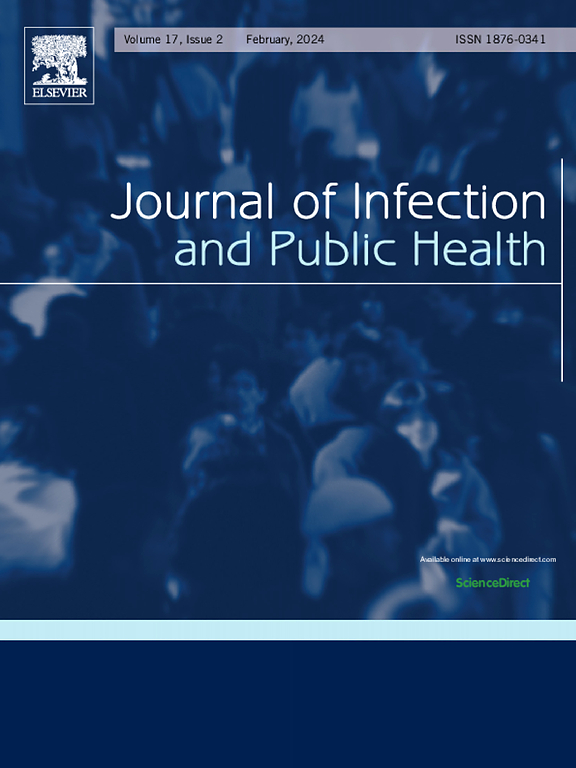COVID-19疫苗中保留免疫原性的反应原性减弱:从初级疫苗到更新的加强疫苗队列的纵向观察
IF 4.7
3区 医学
Q1 INFECTIOUS DISEASES
引用次数: 0
摘要
鼓励高危人群每年更新COVID-19疫苗接种对公共卫生至关重要。然而,对重大反应原性的担忧持续存在,导致对疫苗的犹豫。为了研究不断变化的COVID-19疫苗反应原性和免疫原性,我们对三个COVID-19疫苗队列进行了纵向分析。方法一组接种野生型(WT) 1 ~ 3剂和WT- ba。4/5双价疫苗;XBB.1.5单价疫苗(MoV)队列;以及正在进行的JN.1 MoV队列研究。使用电子日记评估8天的反应原性,并通过定量抗刺突蛋白抗体(Sab)测定血清学反应。对WT SARS-CoV-2和疫苗特异性变体进行斑块减少中和试验(PRNT)。结果共纳入受试者290人,690剂疫苗,1222个采样点。从WT第1次剂量到jn1 MoV,总症状评分依次下降,在较年轻的年龄组中变化明显(<; 45岁;Spearman r = -0.13,P = 0.008)。在年龄较大的年龄组(≥45岁)中变化不明显,反应原性一直较低。严重反应也从26.2% % (WT 1)稳步下降到3.3 % (JN.1 MoV)。血清学分析显示疫苗接种后Sab滴度趋于稳定,疫苗接种前水平升高,对疫苗株的PRNT反应强劲。在第一次WT剂量后,年龄与Sab水平呈负相关,但在随后的剂量中没有。多变量分析发现反应原性和免疫原性之间无显著关联。结论观察到的反应性下降以及持续的免疫反应,支持了年度COVID-19加强疫苗接种计划的安全性和有效性。本文章由计算机程序翻译,如有差异,请以英文原文为准。
Diminishing reactogenicity with preserved immunogenicity in COVID-19 vaccines: A longitudinal observation from primary to updated booster vaccine cohorts
Background
Encouraging annual updated COVID-19 vaccinations for high-risk populations is crucial for public health. However, concerns about significant reactogenicity persist, contributing to vaccine hesitancy. To investigate evolving COVID-19 vaccine reactogenicity and immunogenicity, we conducted a longitudinal analysis across three COVID-19 vaccine cohorts.
Methods
The Primary Vaccine Cohort, receiving wild-type (WT) 1st to 3rd doses and WT-BA.4/5 bivalent vaccine; the XBB.1.5 Monovalent Vaccine (MoV) Cohort; and the ongoing JN.1 MoV Cohort were investigated. Reactogenicity was assessed using electronic diaries for eight days, and serological responses were measured through quantitative anti-spike protein antibody (Sab) assay. Plaque reduction neutralization testing (PRNT) was performed against WT SARS-CoV-2 and vaccine-specific variants.
Results
A total of 290 participants with 690 vaccine doses and 1222 sampling points was included. Total symptom scores decreased serially from the WT 1st dose to JN.1 MoV, with changes pronounced in the younger age group (< 45 years; Spearman r = -0.13, P = 0.008). Changes were not evident in the older age group (≥ 45 years) with consistently low reactogenicity. Severe reactions also steadily declined from 26.2 % (WT 1st) to 3.3 % (JN.1 MoV). Serological analysis revealed plateauing post-vaccination Sab titers with increasing pre-vaccination levels and robust PRNT responses against vaccine strains. Age negatively correlated with Sab levels after the 1st WT dose but not in subsequent doses. Multivariable analysis found no significant association between reactogenicity and immunogenicity.
Conclusion
The observed decline in reactogenicity, alongside sustained immunological responses, supports the safety and efficacy of annual COVID-19 booster vaccination programs.
求助全文
通过发布文献求助,成功后即可免费获取论文全文。
去求助
来源期刊

Journal of Infection and Public Health
PUBLIC, ENVIRONMENTAL & OCCUPATIONAL HEALTH -INFECTIOUS DISEASES
CiteScore
13.10
自引率
1.50%
发文量
203
审稿时长
96 days
期刊介绍:
The Journal of Infection and Public Health, first official journal of the Saudi Arabian Ministry of National Guard Health Affairs, King Saud Bin Abdulaziz University for Health Sciences and the Saudi Association for Public Health, aims to be the foremost scientific, peer-reviewed journal encompassing infection prevention and control, microbiology, infectious diseases, public health and the application of healthcare epidemiology to the evaluation of health outcomes. The point of view of the journal is that infection and public health are closely intertwined and that advances in one area will have positive consequences on the other.
The journal will be useful to all health professionals who are partners in the management of patients with communicable diseases, keeping them up to date. The journal is proud to have an international and diverse editorial board that will assist and facilitate the publication of articles that reflect a global view on infection control and public health, as well as emphasizing our focus on supporting the needs of public health practitioners.
It is our aim to improve healthcare by reducing risk of infection and related adverse outcomes by critical review, selection, and dissemination of new and relevant information in the field of infection control, public health and infectious diseases in all healthcare settings and the community.
 求助内容:
求助内容: 应助结果提醒方式:
应助结果提醒方式:


